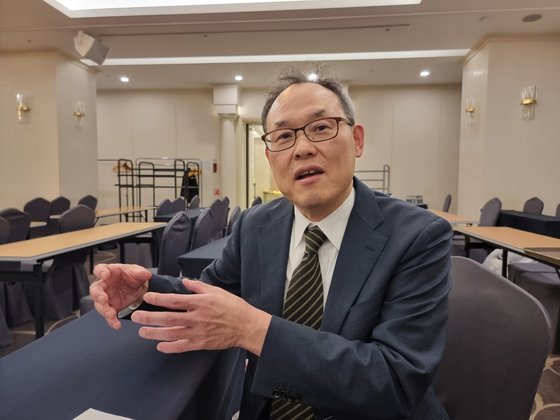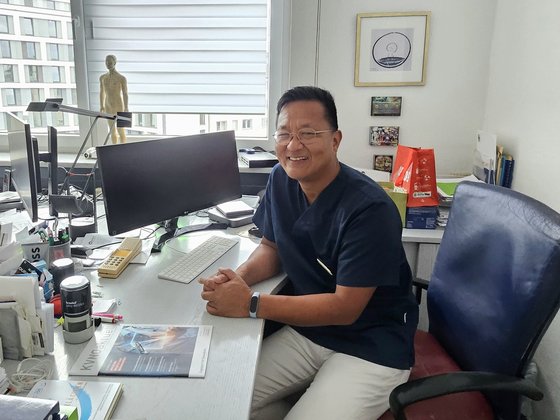Yang Han-chuan, honorary chairman of the Taiwan Medical Association (right), and Taiwan Veterans General Hospital Vice Director Li Yuichang are introducing Taiwan’s non-reimbursement management system and providing advice on how to resolve the Korean medical strike. Taipei = Reporter Shin Seong-sik
JoongAng Ilbo covered the status of non-covered medical care in Germany, Taiwan, and Japan last September and October. Doctors from the three countries provided advice not only on non-benefit management methods but also on the expansion of medical schools in Korea. All three countries have in common a social insurance-type medical system that operates health insurance by collecting insurance premiums.
Korean medical care as seen by German, Japanese, and Taiwanese doctors
Yang Han-chuan, honorary chairman of the Taiwan Medical Association (an organization that combines the Korean Hospital Association and the Medical Association), pointed out the problems with Korea’s 2,000-person increase at the association’s office. Honorary Chairman Yang served as the head of the Department of Health and Welfare of Taiwan and designed Taiwan’s national health insurance.
First, he asked, “What is very questionable is why are you trying to increase the number of people by 2,000 at once?” He said, “Taiwan’s medical school capacity was 1,000 in the early 1990s, and now it is 1,300. When I was serving as head of the Department of Health (now the Department of Health and Welfare), I rejected almost all requests to increase the number of medical schools.” He explained the reason, saying, “We controlled this because, as the number of doctors increases, health insurance spending naturally increases.”
Liu Yichang, vice director of Taipei Veterans General Hospital (professor and internist at National Yangming Jiaotong University), proposed three principles for increasing the number of medical schools. He said, “We should gradually increase it considering health insurance spending and strictly manage it by treatment subject rather than increasing the overall number to avoid a shortage of doctors in specific treatment subjects.” He added, “We must introduce a government-funded international student system that trains doctors to work in the region for 3 to 10 years.” Vice Director Lee is also a former government-sponsored student studying abroad. The income of local doctors who are government-funded international students is 33% higher than that of doctors at public hospitals. Also, large hospitals dispatch doctors to help small local hospitals.

Richard Wu, secretary of the Taiwan Private Hospital Association, explains Taiwan’s non-reimbursement system. Taibe = Reporter Shin Seong-sik
Richard Wu, secretary-general of the Taiwan Private Hospital Association, said, “Doctors are flocking to fields such as ophthalmology and plastic surgery, which also require a lot of non-reimbursement, and there is a shortage of doctors in areas such as surgery. However, this is a problem that can be solved by increasing the fee, not by increasing the number of medical students.” “No,” he said.
However, a line was drawn against collective action. Taiwan’s total contract system (a strong control system that sets the rate of increase in the total amount of health insurance and contracts between the government and medical institutions) and non-reimbursement price controls are more disadvantageous than Korea for doctors. Vice Director Lee said, “The social status of doctors in Taiwan is as high as that in Korea and Japan. The reason they are recognized so much is because of moral obligations. When I was a medical student, I said, ‘It doesn’t matter if I graduate and earn money. However, don’t forget that social respect does not come only from income. “I learned that the profession of a doctor does not exist only for money,” he says. He said, “I can’t help but think about how citizens will view me if I go out and protest for personal gain.” Vice Director Lee added, “The income of Korean doctors is much higher than that of Taiwan. The moment their income exceeds a certain level, they unite and respond more strongly to solidify their interests.”
Honorary Chairman Yang said, “There were protests by doctors at the clinic level, but there are no secondary or tertiary hospitals. Who would agree to a strike at a large hospital?”
Secretary Richard Woo said, “Looking at the situation in Korea, it is not easy for a doctor to have that kind of courage to respond to the government, but I think it’s amazing. And it’s amazing that he’s been doing it for this long.” He said, “Taiwanese doctors have high incomes. If they go on strike, it is difficult to get the consent of society. And doctors have weak unity. However, I also often negotiate with the government, and I understand the current situation in Korea.” In Taiwan, 1,000 to 2,000 doctors protested when the fee contract was signed or when the division of medicine and medicine was implemented (1997), but it is said that there has been no protest in the past 10 years.

Shin Yong-moon, chairman of Kobe Neurology Home Clinic, Japan.
Chairman Shin Yong-moon, a Korean-Japanese neurologist, said, “The Japanese Medical Association does not fight with the government. The Medical Association makes demands to the government, but does not go on strike.” Chairman Shin added, “I don’t know why Korea doesn’t introduce a system like Japan’s local doctor system.” Director Isao Sugimoto, a practicing doctor in Kobe, said, “A demonstration like Korea’s to increase the number of medical schools cannot happen in Japan. Considering the shortage of doctors in Japan, the government considered increasing doctors and providing medical compensation,” adding, “Thanks to the increase in medical schools, there are many people in unpopular departments. “I lost,” he said.

Byeongjin Moon, a Korean-American doctor living in Germany who has been running an orthopedic clinic in Bonn, Germany for 13 years, is explaining the non-reimbursement system. This = Reporter Nam Soo-hyun
Director Byeong-jin Moon, an orthopedic surgeon in Bonn, Germany, said, “The biggest motivation for many medical students in Germany seems to be the desire to help others. In Korea, many people start out as doctors expecting a high income, but in Germany “That’s not the case,” he said. He added, “It is true that being a doctor in Germany is a job with a decent income, but it is not a high-income job like in Korea.”
※This project was supported by the Press Promotion Fund raised through government advertising fees.
◇Special reporting team = Welfare reporter Shin Seong-sik, Jeong Jong-hoon, and Nam Soo-hyun [email protected]

